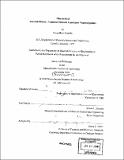| dc.contributor.advisor | Edwin L. Thomas. | en_US |
| dc.contributor.author | Ha, Yung-Hoon Sam, 1975- | en_US |
| dc.contributor.other | Massachusetts Institute of Technology. Dept. of Materials Science and Engineering. | en_US |
| dc.date.accessioned | 2006-03-24T18:07:33Z | |
| dc.date.available | 2006-03-24T18:07:33Z | |
| dc.date.copyright | 2002 | en_US |
| dc.date.issued | 2003 | en_US |
| dc.identifier.uri | http://hdl.handle.net/1721.1/29969 | |
| dc.description | Thesis (Ph. D.)--Massachusetts Institute of Technology, Dept. of Materials Science and Engineering, February 2003. | en_US |
| dc.description | Includes bibliographical references. | en_US |
| dc.description.abstract | The fundamental role of the layered-silicates in a styrene-butadiene-styrene triblock copolymer (SBS) as a function of layered-silicate dispersion during deformation was investigated. Predominantly immiscible composites of mixed morphology provided the initial proof that dramatic alteration of the SBS deformation behavior exists, but a clear understanding of the nature of reinforcement was precluded due to the fiber symmetric orientation of the SBS and the mixed clay morphologies. Following the theory of Vaia and Giannelis, use of a more hydrophobic organically modified clay resulted in an intercalated morphology with a near single crystalline texture of the SBS due to roll-casting. Significant heterogeneous deformation was observed at ambient conditions as well as at elevated temperature as verified through Cohen's affine deformation model in combination with Kratky's scattering pattern model. The intercalated morphology shows little or modest mechanical property enhancements at all temperatures studied. Exfoliated nanocomposite was produced by functionalization of the clay surfaces with polystyrene, altering the enthalpic interactions. Entropic interactions were also controlled by varying the molecular weight of the surfactant and the grafting density and shows remarkable agreement with the theory proposed by Balazs et al. Due to the increase surface volume ratio of the clay, a flipping transition of the block copolymer morphology was observed during roll-casting producing a near single crystalline parallel/parallel clay/BCP orientation. The modulus was relatively unaffected whereas the toughness increased significantly due to an earlier onset of strain hardening. | en_US |
| dc.description.statementofresponsibility | by Yung-Hoon Sam Ha. | en_US |
| dc.format.extent | 228 leaves | en_US |
| dc.format.extent | 11890513 bytes | |
| dc.format.extent | 22404635 bytes | |
| dc.format.mimetype | application/pdf | |
| dc.format.mimetype | application/pdf | |
| dc.language.iso | eng | en_US |
| dc.publisher | Massachusetts Institute of Technology | en_US |
| dc.rights | M.I.T. theses are protected by copyright. They may be viewed from this source for any purpose, but reproduction or distribution in any format is prohibited without written permission. See provided URL for inquiries about permission. | en_US |
| dc.rights.uri | http://dspace.mit.edu/handle/1721.1/7582 | |
| dc.subject | Materials Science and Engineering. | en_US |
| dc.title | Hierarchical layered-silicate-- lamellar triblock copolymer nanocomposites | en_US |
| dc.type | Thesis | en_US |
| dc.description.degree | Ph.D. | en_US |
| dc.contributor.department | Massachusetts Institute of Technology. Department of Materials Science and Engineering | |
| dc.identifier.oclc | 54763926 | en_US |

